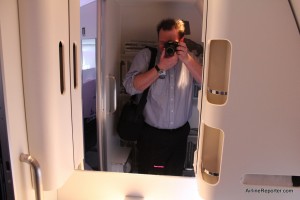
Oh noes! Will AvGeeks be safe taking Laviator photos in the future? Taken on Air New Zealands Boeing 777-300ER
The Federal Aviation Administration ordered airlines to remove the oxygen tanks located in lavatories in 6000 aircraft across the United States. The FAA determined that someone could use the oxygen tanks to start a fire or to create a bomb. The Air Worthiness Directive 2011-04-09 stated that airlines had to comply over a 21-day period, ending on March 4th. The entire process was kept a secret to the general public, since the FAA did not want someone to use the information for evil doing.
This means that if cabin pressure is lost mid-flight, there would be no oxygen mask for a passenger in the bathroom. This has some people very upset (and afraid), but really flight attendants are trained to take care of you and although some people think depressurization happens all the time it is a very rare situation — especially when you think about how many flight hours are completed in the US on a daily basis. I would rather take the risk of being in the bathroom during decompression versus someone using the oxygen container for something bad.
So why have the bathroom oxygen tanks been removed, but not the others in the main cabin? I suspect the ones in the lavatories were targeted since passengers have a pretty high level of privacy and could barricade themselves in. The airlines and aircraft manufactures are working on a better solution (I am thinking an alarm to access the oxygen tank?), but there is no word when oxygen will be re-activated in the lavatories.
To learn more, check out my story on AOL Travel News (http://aol.it/ex6xq5).
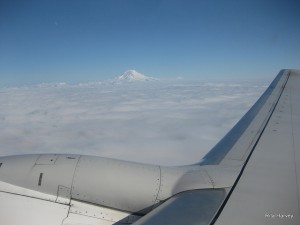
A nice view of Mount Rainier.
Not that long ago I wrote a blog talking about Koito falsifying the safety of their seats and about three Eva Air Boeing 777’s sitting at Paine Field with no seats. Well, the story now gets better (or I guess worse).
Mary Kirby on FlightGlobal.com highlights the new issues facing the Koito seats. Due to Koito’s lack of following proper procedures 150,000 seats flown all over the world could have unknown safety issues and now the Federal Aviation Administration (FAA) and the European Aviation Safety Agency (EASA) have proposed airworthiness directives (AD) for the seats. The EASA proposal is a bit more strict than the FAA.
“The Japanese airworthiness authority (JCAB) has informed EASA that a review of the safety of passenger seats manufactured by Koito industries has disclosed discrepancies which include falsification of static, dynamic and flammability testing, as well as uncontrolled changes to production data (material and dimensional),” says EASA in its proposed AD.
“In addition JCAB confirmed that Koito records, showing evidence of falsification, could not be deemed complete. Examples include: fictitious dynamic test pulse plots inserted into test reports following failure to meet required certification requirements; flammability test coupons not representative of production parts, for instance by use of alternative adhesive not specified on the approved drawing; and fictitious deformation values entered in test reports when values exceeded the maximum allowed.”
Because of all the issues, the EASA has asked airlines to remove all Koito seats with-in the next two years. However, if additional testing shows the seats are safe, this could be changed to ten years. The FAA’s proposal puts it onto the airlines to test the seat’s safety. If airlines determine the seats are unsafe, they must be removed.
“Because this proposed AD will not require full compliance with every applicable regulation, seats on which the requirements of this proposed AD are completed successfully and are permitted to remain in service are limited in how they can be used. That is, unless they are shown to fully comply with the regulatory requirements, this proposed AD would restrict the installation of such seats and would require specific marking. These seats can be used as a direct spare for the same part number seat. However, any other use of such seats would be considered a new installation approval and would be required to comply with all regulations. Thus, seats not meeting all regulations could not be installed except as noted above, and if removed from an approved arrangement, would have to be destroyed or rendered unusable in some other manner acceptable to the FAA,” says the agency in its proposed AD.
The FAA estimated that its directive would affect 40,365 seats on 278 airplanes in the US with a total estimated cost of $875,000. However, I assume that the cost would be much higher than that.
Flight Global asked the FAA if they are concerned that unfavorable comparisons will be made about the their AD versus the EASA’s. An FAA spokesman explained, “Clearly the FAA doesn’t operate in a vacuum, but that said what we have to do is look at the safety impact and the safety issue and the proposed solution based on our environment, not the environment that exists in Europe.”
Most of the Koito seats flying in the US are on Continental Airlines aircraft. It looks like they anticipated this direction and have already started testing. “We’ve been working closely with the FAA over the past year in anticipation of the proposed rulemaking and have completed initial testing on the majority of our aircraft,” Julie King with Continental Public Relations explained to me via an email.
I started looking into this story because of the three Eva Air Boeing 777’s sitting at Paine Field, so I wanted to check in with them to see their status. They are still sticking with the, “no comment,” stance, which again, is not surprising.
So, what does this mean to you? Not too much, unless it turns out these seats are unsafe you end up sitting in one during an incident. However, as explained earlier, the chances of being in any airline seat during an accident, is very rare, being in a Koito seat is even less likely.
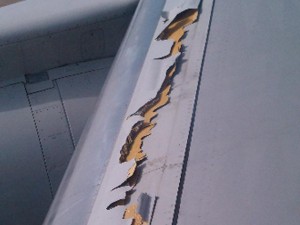
The rear of the slate is de-laminating on this American Airlines Boeing 757 on flight 1990.
Last Saturday American Airlines flight 1990 was about to take off from Miami to Orlando, when a passenger noticed a bit of damage to the wing’s right slat. As the flight of the Boeing 757 progressed the passenger, who wishes to remain anonymous, noticed the small damage had spread to the width of several feet and he notified one of the flight attendants.
WESH of Orlando spoke with American spokesperson, Tim Smith, and he confirmed that the Boeing 757 did have some de-lamination on the plane’s right wing. He stated the plane was taken out of service and ferried back to Miami to have repairs completed. Smith stated the de-lamination occurred on the rear of one of the wing’s slats, and even if the problem had affected the operation of the slat, the slats simply make the plane more aerodynamic but do not affect the plane’s ability to fly safely.
“I really do want to assure folks that safety wasn’t compromised and no one was in any danger because of this,” he said.
Some others aren’t so sure. Eric Norber of Orlando FAA Safety Team feels that the pilots should have made an emergency landing. At first glance this might look like a serious incident, but I am not so sure.
First off the flight from Miami to Orlando is extremely short and it might have taken longer for the pilot to make an emergency landing back in Miami versus continuing to Orlando. Obviously American felt it was not a safety risk, since the plane was flown back to Miami with no passengers aboard.
Ice or debris on the leading edge of slats can cause a loss of lift and serious issues, however the damage was on the rear of the slats and appears to be mostly cosmetic. While the rear of the slat is make of laminated composite material, the front part is made of alloy and the damage would not been able to spread.
That being said, I will continue to find out more information about this incident, but on the most part, this might just be a non-incident (except for a few interesting photos).
Someone on Airliners.net also posted a very cool image showing how the rear of the slat (this photo is of a Boeing 747, but still similar construction) is to the front.
Thanks Chris S for pointing this story out!
Image: WESH
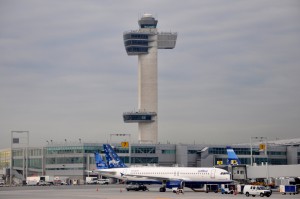
John F. Kennedy International Airport's control tower with a few jetBlue Airbus A320's in front
Ah, “Bring Your Kid To Work Day,” is a classic. It is nice that your children are able to see what mommy and daddy do all day and your co-workers get to meet your little ball of joy you talk about so much.
However there are some jobs that it might be best for your child to skip visiting. On the surface it might seem harmless to bring your child to work if you are an air traffic controller. Maybe during your time off you can show him the view, let him see those big radar screens and listen to some of your co-workers in action.
Well, one traffic controller at JFK wanted his kid to get the full experience and let him talk to pilots. On a recording found on Gadling, it is quite clear the child is talking directly to the pilots, being assisted by his parent. The pilots don’t seem too put off by this, but the FAA sure isn’t amused.
An FAA spokesperson stated, “Pending the outcome of our investigation, the employees involved in this incident are not controlling air traffic. This behavior is not acceptable and does not demonstrate the kind of professionalism expected from all FAA employees.”
Sure, this might have been a little more “fun” at a smaller airport directing Cessna 172’s, not at JFK, directing large Boeing 747’s. I know I would feel a bit more comfortable knowing there aren’t children directing my next flight out of JFK.
connect | web | twitter | facebook |
Image: TVL1970
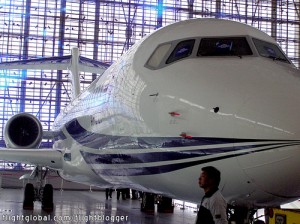
ARJ21-700 Roll Out in Shanghai December 21, 2007 from Flight Blogger
Since the Chinese-made ARJ21 was announced I have wondered if it would ever make it to production. Although there have been quite a few delays (it was supposed to go into service in early 2007), the plane (which is heavily based on the MD-80) is still on track to succeed.
China has been making aircraft for quite sometime, but only sold them to countries with lax safety regulations. This week the Federal Aviation Administration (FAA) is going to be checking Civil Aviation Administration of China’s (CAAC) ability to certify the ARJ21.
If the FAA certifies CAAC and CAAC certifies the ARJ21, then the ARJ21 can be sold globally. Currently there are three ARJ21’s in the test fleet, but they are only about 150 flight hours into the 2000 flight hours required to get Chinese certification. They were hoping to have Chinese certification of the aircraft done by the end of 2010, but it looks unlikely that will happen.
Would any US or European start-up airlines would be willing to try out using an all-ARJ21 fleet in the future? Right now I would guess no, but things can change.
More Information:
* Office website of the ARJ21
* A few photos of the ARJ21 from Airliners.net
* Wikipedia write up on the ARJ21
connect | web | twitter | facebook |
Source: Flight Global Image: Flight Blogger




